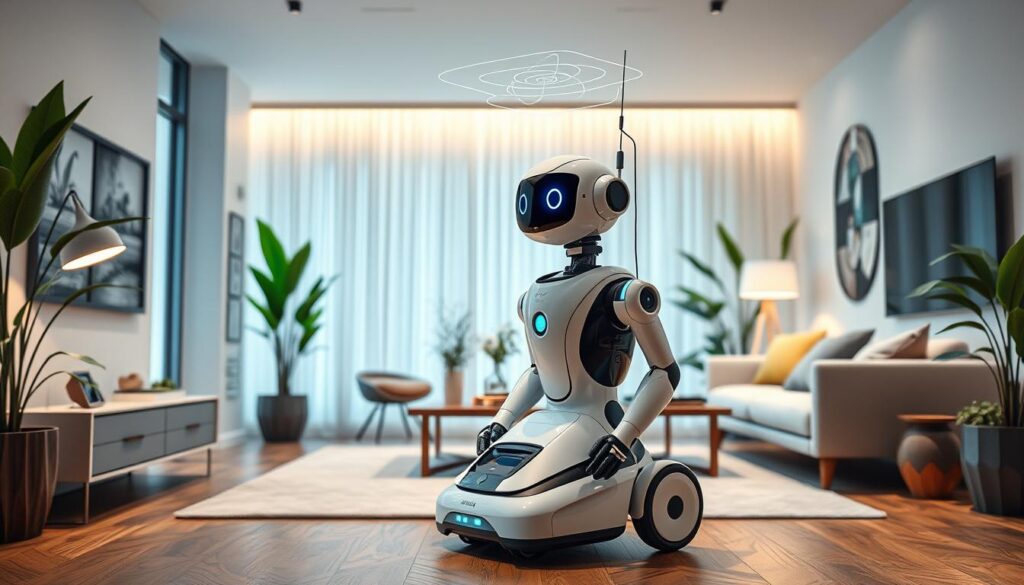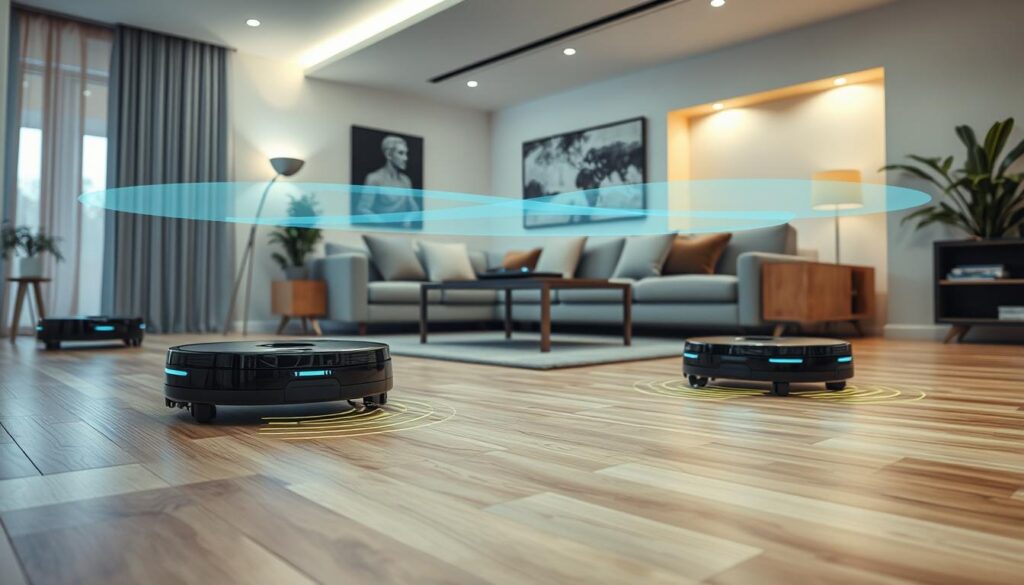Robots are becoming more common in homes and industries. They need to be safe and reliable, especially when working with people. LIDAR sensors are key in making home robots safer and better at navigating.
LIDAR uses 3D point clouds and machine learning to map spaces and avoid obstacles. This helps prevent accidents. It’s a big step forward in making robots work well in homes.
LIDAR and GPS together have changed surveying and mapping. They allow for detailed land surveys from the air. Adding LIDAR to home robots makes them navigate better, avoid obstacles, and map their surroundings accurately.
This leads to more efficient and safer home automation. LIDAR sensors help robots know where objects are by creating 2D or 3D point clouds.
LIDAR sensors help robots navigate and avoid obstacles. Navigation LIDAR maps the area, while obstacle avoidance LIDAR stops collisions. Robots with LIDAR can find distances to static objects but struggle with moving ones.
Introduction to LIDAR Technology
LIDAR, short for Light Detection and Ranging, is a game-changing sensor tech. It’s changing how robots and self-driving systems see and move around. This tech uses laser pulses to make detailed 3D maps of spaces. This lets lidar technology, 3D mapping, and autonomous navigation happen in ways we never thought possible.
What is LIDAR?
LIDAR is a way to sense the world using light. It sends out laser pulses and measures how long it takes for them to bounce back. This lets LIDAR systems create accurate point clouds of the area around it.
How LIDAR Sensors Work
LIDAR sensors have a laser, a scanner, and a receiver. The laser sends out light pulses, the scanner directs them, and the receiver catches the echoes. This info is turned into a point cloud by machine learning and sensor technology. This helps robots move around on their own.
The LiDAR robot uses a Neato XV-11 LiDAR and four motors for movement. It can move at about 285 RPM and go up to 349 RPM. The LiDAR system sends data to a Raspberry Pi via USB. It collects data in 360 degrees, with each degree having 90 packets of info. The data includes distance and signal strength, and it can detect objects as close as 150mm.
LIDAR sensor technology lets robots and self-driving systems move with great confidence. They can spot obstacles, map out areas, and make smart choices. This ensures they operate safely and efficiently.
Home Robot Development with LIDAR
Safety and Navigation of Home Robots
LIDAR technology has greatly improved home robots’ safety and navigation. LIDAR sensors help these robots move safely around their environments. They can even work with humans nearby without causing harm.
These sensors give robots detailed distance information. This lets them avoid obstacles easily. It’s key for robots to safely and efficiently work with humans in the same space.
- According to the IEEE, smart home robots, or consumer robots, are robots designed for tasks and chores within households, with little or no human interference.
- Advanced house robots are equipped with sensors, cameras, and algorithms powered by AI for environment interaction.
- Household robots contribute to improving quality of life by handling functional household tasks efficiently.
| Applications for Home Robots | Examples |
|---|---|
| Cleaning and Maintenance | Robotic vacuum cleaners |
| Security and Surveillance | Security and monitoring robots |
| Entertainment and Companionship | Social and companion robots |
| Education | Educational robots |

LIDAR-equipped home robots can map their surroundings well. This is crucial for safe and efficient work with humans. They use robotic safety and autonomous navigation to move safely. This ensures dynamic safety zoning and collision avoidance.
Advantages of LIDAR for Home Robots
LIDAR technology is a top choice for home robots. It offers lidar precision and lidar accuracy in mapping and measuring. These are key for home robots to navigate and perform tasks.
Precision and Accuracy
LIDAR creates detailed 3D point clouds of a robot’s space. This helps in precise navigation and detecting obstacles. It’s also great for mapping the environment.
LIDAR works well in any light, unlike cameras that struggle in the dark. This makes it a better choice for home robots.
Low-Light Performance
LIDAR shines in low-light navigation and environmental mapping. It doesn’t need visible light to work. This means home robots with LIDAR can move safely in dark places.
LIDAR’s precision, accuracy, and low-light skills are key for home robots. They improve safety and performance in many home settings.
LIDAR in Autonomous Cleaning Robots
The world of robot vacuums has changed a lot with LIDAR technology. These smart devices use advanced sensors and mapping to clean homes efficiently. They are much better than old vacuum cleaners.
LiDAR vs. vSLAM for Robot Vacuums
Robot vacuums use two main technologies: LIDAR and vSLAM. vSLAM uses cameras to map a home. LIDAR uses laser sensors for a precise 3D map.
LIDAR robots are more accurate, especially in big or complex homes. vSLAM robots might be less accurate but adjust better to changes. The choice depends on the home’s needs, with LIDAR being better in dark places and big areas.
By 2025, there will be more autonomous cleaning robots than now. LIDAR robot vacuums will be key in making cleaning efficient for all homes.

LIDAR’s benefits in robot mapping and cleaning efficiency are clear. But, safety standards also drive these robot’s development. In June 2021, new safety standards were set for these robots.
The Kärcher KIRA B 50 is a great example. It has three nanoScan3 safety scanners and the Flexi Soft controller. It supports up to 128 protective fields for safe navigation. Kärcher is expanding its LIDAR-navigated cleaning robots fleet, showing LIDAR’s growing role in home automation.
Emerging Applications of LIDAR in Home Automation
LIDAR technology is changing home automation in exciting ways. It’s not just for home robots and cleaning devices anymore. Now, it’s used in smart home tech, like augmented reality and indoor navigation.
LIDAR scanners are making AR on mobile devices better. They give accurate depth info, making virtual things feel real. This tech is changing how we use AR at home, mixing digital and physical in cool ways.
LIDAR also helps with indoor navigation. It maps out places like airports and malls, and even our homes. This makes it easier to get around, changing how we move in our spaces.
LIDAR is making our homes smarter in many ways. It’s all about better AR and easier navigation. This tech is key to the future of smart homes, bringing us more precision and ease.
| LIDAR Product | Key Features | Availability |
|---|---|---|
| SICK LMS111-10100 Laser Range Finder | Compact size, cost-effective, suitable for indoor and outdoor applications | In stock |
| YDLIDAR G2 Scanner | 360° scanning, high-speed performance | In stock |
| YDLIDAR G4 360° Laser Range Finder | 360° coverage, robust performance | In stock |
| YDLIDAR G6 360° Laser Range Finder | Compact design, 360° scanning | In stock |
These LIDAR products show how versatile and popular this tech is. It’s used in many home automation areas, from navigation to sensors. As smart homes become more common, LIDAR will be crucial for their development.
Conclusion
LIDAR technology is key for making home robots and automation systems better. It helps measure distances, map environments, and work well in low light. This makes home robots safer and more efficient.
Robot vacuums with LIDAR clean better and faster. Smart home tech also benefits, offering better experiences and navigation. LIDAR is set to make our homes safer, smarter, and more efficient.
As LIDAR and other tech improve, we’ll see even more changes in home robots and automation. These advancements will change how we live, making our homes more efficient and sustainable. We’re looking forward to a future where our homes are more intelligent and tailored to our needs.

